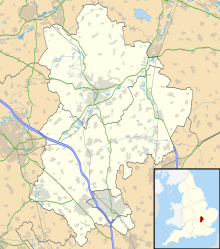| Cranfield Airport | |||
|---|---|---|---|
| IATA: none – ICAO: EGTC | |||
| Summary | |||
| Airport type | Private, former RAF Station | ||
| Operator | Cranfield University | ||
| Serves | Bedford, Milton Keynes | ||
| Location | Cranfield | ||
| Elevation AMSL | 358 ft / 109 m | ||
| Coordinates | 52°04′20″N 000°37′00″W / 52.07222°N 0.6166667°WCoordinates: 52°04′20″N 000°37′00″W / 52.07222°N 0.6166667°W | ||
| Website | |||
| Map | |||
| Location in Bedfordshire | |||
| Runways | |||
| Direction | Length | Surface | |
| m | ft | ||
| 03/21 | 1,799 | 5,902 | Asphalt |
| Sources: UK AIP at NATS[1] | |||
Cranfield Airport (ICAO: EGTC) is an airfield just outside the village of Cranfield, 7 NM (13 km; 8.1 mi) south-west of Bedford in Bedfordshire, England. It was originally a World War II aerodrome, RAF Cranfield.
Cranfield Aerodrome has a CAA Ordinary Licence (Number P803) that allows flights for the public transport of passengers or for flying instruction as authorised by the licensee (Cranfield University)[2] situated next to the site.
Cranfield is used extensively by fixed-wing and helicopter flight training organisations, of which there are many who operate out of the field. Additionally, general aviation, small business aircraft and private jets make use of the facilities. The airfield is 3 mi (4.8 km) from the M1 motorway and the city of Milton Keynes, making it the nearest to the town. Although the length of the runway means that Cranfield can handle some larger airliners, the rest of the immediate infrastructure is not geared up for passenger flights. The nearest such airport is London Luton Airport.
Facilities for pilots include Non-directional beacon 'CIT 850' which is located 3.5 NM (6.5 km; 4.0 mi) to the north-east of the aerodrome and 'ICR 108.9' Instrument landing system for runway 21. New to Cranfield airport is they now have DME serviceable for runway 21.
RAF Cranfield[]
It was built on 100 acres (0.40 km2) of farmland acquired by the Air Ministry in 1935 as Britain re-armed to face the growing threats on the continent. It was formally opened on 1 June 1937 and initially became the base for No. 62 Squadron RAF and No. 82 Squadron RAF of No. 1 (Bomber) Group, flying the already obsolescent Hawker Hind biplanes.
Both squadrons converted to Blenheim 1s in 1938. 62 Squadron was moved to Singapore in August 1939 where it was destroyed by the invading Japanese. RAF Cranfield's grass airstrip was replaced with three hardened runways in the winter of 1939 and spring of 1940 and became a target for enemy action in the late summer of that year, with mines, bombs and incendiaries dropped on it and the nearby village of Cranfield.
Aircraftsman Vivian Hollowday, serving at the airfield, won the George Cross for the attempted rescue of two crews which crashed there in July and August 1940.[3]
August 1941 saw the fast developing station become a night fighter training centre with the arrival of No. 51 Night fighter Operational Training Unit. This was disbanded after the end of the war in Europe in June 1945 and the airfield became the site for a new College of Aeronautics. This college helped develop the highly successful Harrier Jump Jet and has serviced the Hurricanes and Spitfires of the Battle of Britain Memorial Flight. The UK's sole remaining airworthy Avro Lancaster was based at Cranfield until 1964.[4][5]
References[]
- ↑ Cranfield - EGTC
- ↑ Civil Aviation Authority Aerodrome Ordinary Licences
- ↑ "Cranfield College of Aeronautics history". pp. 4. http://wwwlegacy.cranfield.ac.uk/about/history/coa_history_final.pdf. Retrieved 17 April 2010.
- ↑ "Cranfield College of Aeronautics history". Cranfield University. pp. 3–4. http://www.cranfield.ac.uk/about/history/coa_history_final.pdf. Retrieved 2009-03-16.
- ↑ "Battle of Britain Memorial Flight - Lancaster history". RAF. http://www.raf.mod.uk/bbmf/theaircraft/lancaster.cfm. Retrieved 2009-08-05.
External links[]
| Wikimedia Commons has media related to Cranfield airfield. |
- Official site
- Cranfield Airport from the air
- Facility for Airborne Atmospheric Measurements
- Control Towers Website: RAF Cranfield
| ||||||||||||||||||||||||||||||||
The original article can be found at Cranfield Airport and the edit history here.

